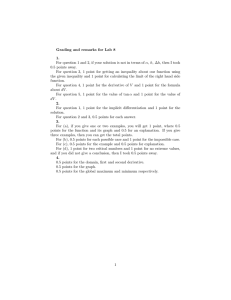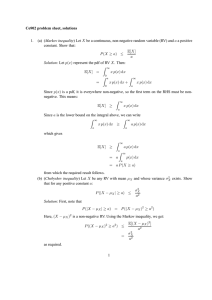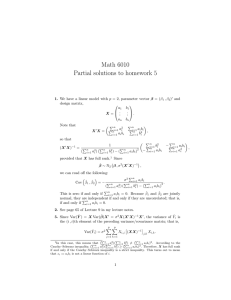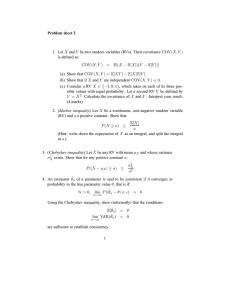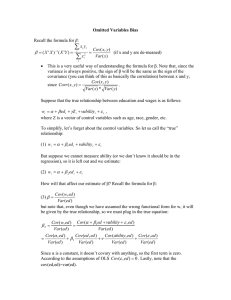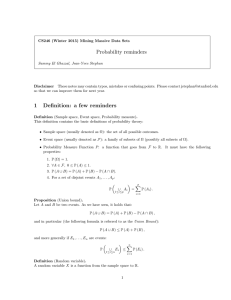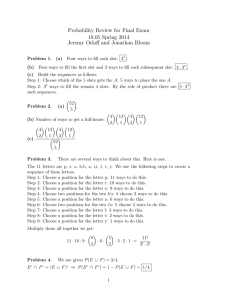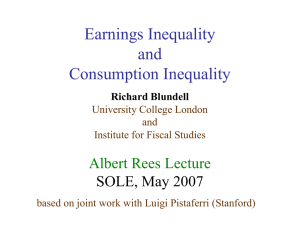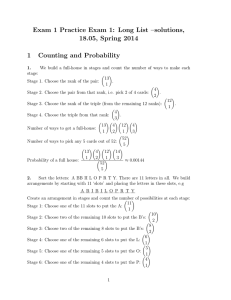Problem sheet 2, solutions. 1(a). From the definition of covariance:
advertisement
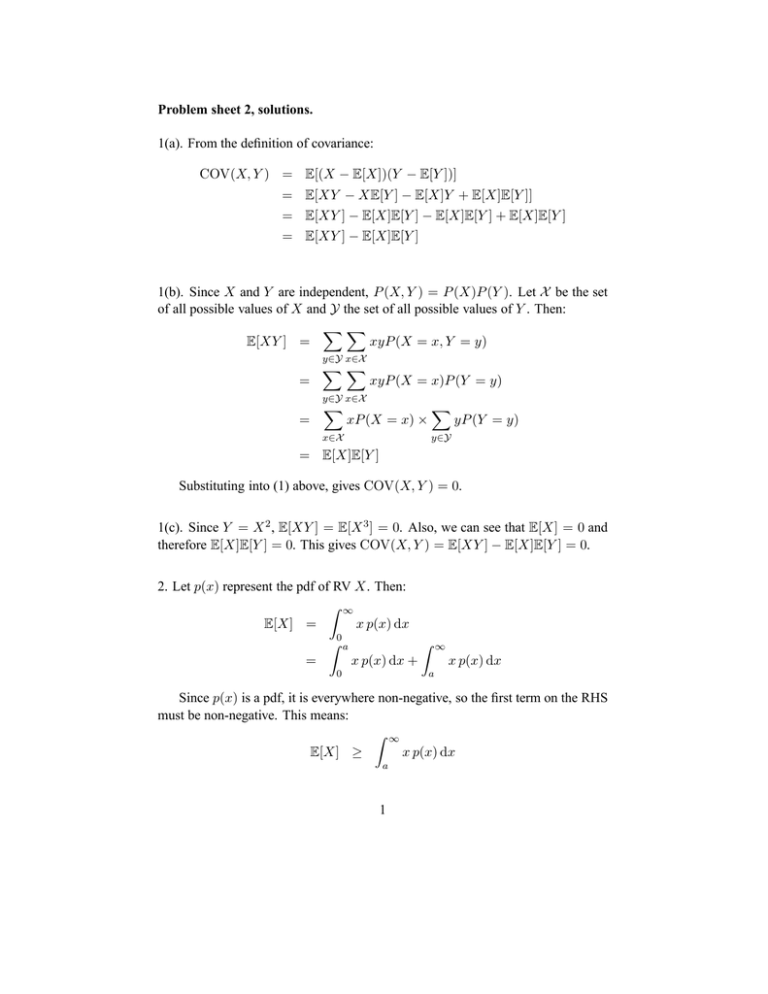
Problem sheet 2, solutions. 1(a). From the definition of covariance: COV(X, Y ) = E[(X − E[X])(Y − E[Y ])] = E[XY − XE[Y ] − E[X]Y + E[X]E[Y ]] = E[XY ] − E[X]E[Y ] − E[X]E[Y ] + E[X]E[Y ] = E[XY ] − E[X]E[Y ] 1(b). Since X and Y are independent, P (X, Y ) = P (X)P (Y ). Let X be the set of all possible values of X and Y the set of all possible values of Y . Then: XX E[XY ] = xyP (X = x, Y = y) y∈Y x∈X = XX xyP (X = x)P (Y = y) y∈Y x∈X = X X xP (X = x) × x∈X yP (Y = y) y∈Y = E[X]E[Y ] Substituting into (1) above, gives COV(X, Y ) = 0. 1(c). Since Y = X 2 , E[XY ] = E[X 3 ] = 0. Also, we can see that E[X] = 0 and therefore E[X]E[Y ] = 0. This gives COV(X, Y ) = E[XY ] − E[X]E[Y ] = 0. 2. Let p(x) represent the pdf of RV X. Then: Z ∞ E[X] = x p(x) dx Z Z0 a x p(x) dx + = ∞ x p(x) dx a 0 Since p(x) is a pdf, it is everywhere non-negative, so the first term on the RHS must be non-negative. This means: Z ∞ x p(x) dx E[X] ≥ a 1 Since a is the lower bound on the integral above, we can write Z ∞ Z ∞ a p(x) dx x p(x) dx ≥ a a which gives E[X] ≥ ∞ Z a p(x) dx a = a Z ∞ p(x) dx a = a P (X ≥ a) from which the required result follows. 3. First, note that P (|X − µX | ≥ a) = P ((X − µX )2 ≥ a2 ) Here, (X − µX )2 is a non-negative RV. Using the Markov inequality, we get: P ((X − µX )2 ≥ a2 ) ≤ = E[(X − µX )2 ] a2 2 σX a2 as required. 4. If θ̂n is unbiased, we can write P (|θ̂n − θ| ≥ ) = P (|θ̂n − E[θ̂n ]| ≥ ) Applying the Chebyshev inequality to the RHS, we get: P (|θ̂n − E[θ̂n ]| ≥ ) ≤ VAR(θ̂n ) 2 From the RHS above we can see that if lim VAR(θ̂n ) = 0 n→∞ the estimator converges in probability to θ, that is, it is consistent. 2 5. Let X̄n denote the sample mean derived from n observations. This is easily shown to be unbiased. Using the Chebyshev inequality: P (|X̄n − µX | ≥ ) ≤ VAR(X̄n ) 2 But: VAR(X̄n ) = VAR = 1 (X1 + . . . + Xn ) n 2 σX n Therefore 2 σX n2 P (|X̄n − µX | ≥ ) ≤ and lim P (|X̄n − µX | ≥ ) = 0 n→∞ which means X̄n converges in probability to the true mean µX , as required. 6(a). Log-likelihood: n L(µ, Σ) = − n 1X dn (Xi − µ)T Σ−1 (Xi − µ) log(2π) − log(|Σ|) − 2 2 2 i=1 6(b). We proceed in two steps: we first treat Σ as fixed, and maximize L to get a value µ̂(Σ) which maximizes L for a given matrix parameter Σ. Taking the derivative of the L wrt vector µ, we get: n X d (Xi − µ))T L = (Σ−1 dµ i=1 Setting the derivative to zero, taking the transpose of both sides and pre-multiplying by Σ, we get: 0 = n X (Xi − µ) i=1 3 Solving for µ: n 1X Xi n µ̂(Σ) = i=1 = X̄ Since this solution does not depend on Σ, X̄ is the maximum likelihood estimator of µ for any Σ. To obtain Σ̂ we plug µ̂(Σ) = X̄ into the log-likelihood to obtain n n 1X dn (Xi − X̄)T Σ−1 (Xi − X̄) log(2π) − log(|Σ|) − − 2 2 2 (1) i=1 and maximize this function wrt Σ. We first introduce a sample covariance matrix S defined as follows: n S = 1X (Xi − X̄)(Xi − X̄)T n i=1 This allows us to re-write the quadratic form in (1) as a matrix trace: n X (Xi − X̄)T Σ−1 (Xi − X̄) = n Tr(Σ−1 S) i=1 where Tr(·) denotes the trace of its matrix argument. This in turn allows us to write the derivative of (1) wrt Σ as follows: − n d n d log(|Σ|) − Tr(Σ−1 S) 2 dΣ 2 dΣ At this point we make use of two useful matrix derivatives (these can be found in Appendix C of Bishop and the note “Matrix Identities” by Roweis, available on the course website): ∂ log(|A|) = (A−1 )T ∂A ∂ Tr(X−1 A) = −X−1 AT X−1 ∂X This gives the derivative (2) in the following form (where we make use of the fact that both Σ−1 and S are symmetric): n n − Σ−1 + Σ−1 SΣ−1 2 2 4 Setting to zero and solving, we get: Σ̂ = S n 1X = (Xi − X̄)(Xi − X̄)T n i=1 5

